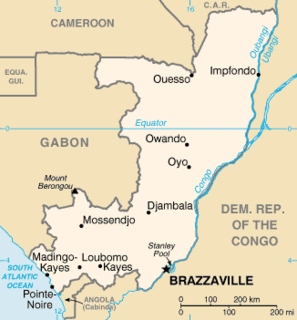
The history of the Republic of the Congo has been marked by diverse civilisations: indigenous, French and post-independence.

The Congo River, formerly also known as the Zaire River, is the second longest river in Africa, shorter only than the Nile, as well as the second largest river in the world by discharge volume, following only the Amazon. It is also the world's deepest recorded river, with measured depths in excess of 220 m (720 ft). The Congo-Lualaba-Chambeshi River system has an overall length of 4,700 km (2,920 mi), which makes it the world's ninth-longest river. The Chambeshi is a tributary of the Lualaba River, and Lualaba is the name of the Congo River upstream of Boyoma Falls, extending for 1,800 km (1,120 mi).

Pietro Paolo Savorgnan di Brazzà, later known as Pierre Paul François Camille Savorgnan de Brazza; 26 January 1852 – 14 September 1905), was an Italian-born, naturalized French explorer. With his family's financial help, he explored the Ogooué region of Central Africa, and later with the backing of the Société de Géographie de Paris, he reached far into the interior along the right bank of the Congo. His friendly manner, great charm and peaceful approach made him popular among Africans. Under French colonial rule, the capital of the Republic of the Congo was named Brazzaville after him and the name was retained by the post-colonial rulers, the only African nation to do so.
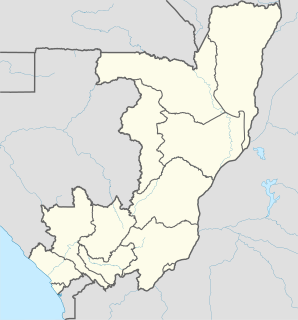
Djambala is the main town of Djambala District and the Plateaux Region of the Republic of Congo. It lies north of Brazzaville and lies near the Léfini Faunal Reserve.

De Brazza's monkey is an Old World monkey endemic to the riverine and swamp forests of central Africa. The largest species in the guenon family, it is one of the most widespread arboreal African primates. Aside from size, it can be differentiated from other cercopithecus monkeys by its orange diadem and white beard. Due to its cryptic nature, the species is not well documented in all of its habitats but has shown unique traits such as pair-bonding and aggressive behavior towards other guenons.
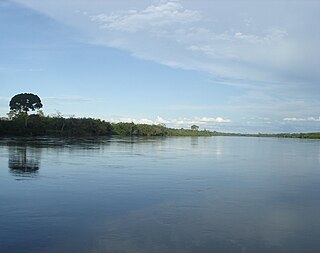
The Western Congolian swamp forests are an ecoregion of the Republic of the Congo and Democratic Republic of the Congo. Together with the adjacent Eastern Congolian swamp forests, it forms one of the largest continuous areas of freshwater swamp forest in the world. It is a flooded forest with a high canopy, dense undergrowth and has a muddy floor. It has not been disturbed very much by outside influences and so remains largely pristine as getting through this forest is called "almost impossible".

Between 1874 and 1877 Henry Morton Stanley traveled central Africa East to West, exploring Lake Victoria, Lake Tanganyika and the Lualaba and Congo rivers. He covered 7,000 miles (11,000 km) from Zanzibar in the east to Boma in the mouth of the Congo in the west and resolved a number of open questions concerning the geography of central Africa. This including identifying the source of the Nile, which he proved was not the Lualaba – which is in fact the source of the river Congo.

Etsouali or Etsouah is a small town in Djambala District in the Plateaux Department of the Republic of the Congo. It lies in the Lefini Reserve, north of Moembe and around 180 kilometres north of Brazzaville on the N2 road.

Onianva is a town in Lekana District in the Plateaux Department of the Republic of the Congo. It lies to the north of the Lefini Reserve, north of Etsouali and on the N2 road.
The Lesio-Louna Reserve is found in the Republic of the Congo. It was established on 28 December 1993. This site is 440.00 km2.
The Léfini Faunal Reserve is a protected reserve of Congo. It was established on November 26, 1951. This site covers 6,300.00 km².
Mpe Bambou is a small village situated in the Plateaux Department (Congo) which is in the north of the Republic of Congo. It lies in the Lefini River, north of Moembe and around 200 kilometres north of Brazzaville on the N2 road.
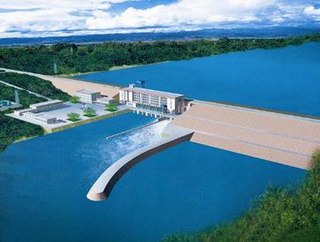
The Imboulou Dam is a dam on the Léfini River, near Ngabé, Ngabe District, Pool Department, Republic of the Congo, about 300 kilometers north of Brazzaville. It was inaugurated by President Denis Sassou-Nguesso on the 7 May 2011.
Albert Fourvelle was a Congolese politician. Fourvelle was of mixed African-European heritage. He worked as a trader, and became an active socialist. In 1952 he was elected to the Territorial Assembly.

Louis Pierre Alphonse Valcke was a Belgian soldier and colonial administrator.
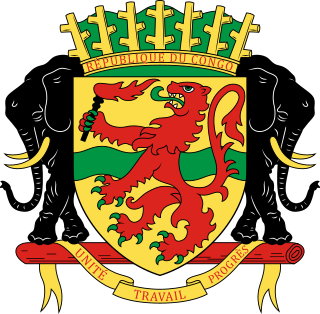
Congolese nationality law is regulated by the Constitution of the Republic of the Congo, as amended; the Congolese Nationality Code, and its revisions; and various international agreements to which the country is a signatory. These laws determine who is, or is eligible to be, a national of the Republic of the Congo. The legal means to acquire nationality, formal legal membership in a nation, differ from the domestic relationship of rights and obligations between a national and the nation, known as citizenship. Congolese nationality is typically obtained under the principle of jus soli, i.e. by birth in the Republic of the Congo, or jus sanguinis, born abroad to parents with Congolese nationality. It can be granted to persons with an affiliation to the country, or to a permanent resident who has lived in the country for a given period of time through naturalization.










